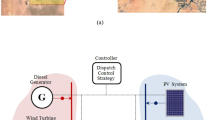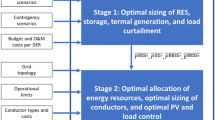Abstract
This paper proposes an optimal stochastic operation strategy for renewable energy (RE) supported isolated microgrids (IMGs). It incorporates an emission-averse model to reduce the negative impact of CO2 emission on the environment by optimally utilizing carbon capture-based technology. The emission from dispatchable sources, viz. diesel engines used to produce electrical energy, adversely affects the environment. Although imposing a penalty cost on carbon emissions reduces its production from such sources, but still, it cannot be avoided. The proposed work introduces a carbon capture-based reduced emission model that incorporates a small-scale carbon capture unit (CCU) incorporated with a fossil fuel-based unit. Depending upon the CCU system efficiency, a fractional penalty has also been imposed on carbon emissions. From the analysis point of view, the efficiency of the CCU is considered as 90%. The overall problem is formulated as a multivariable constrained cost optimization problem to obtain the optimal dispatch of various connected sources and is solved through a hybrid function approach using the ‘fmincon’ solver in the MATLAB environment. The results are analyzed for the techno-economically viability of the IMG system with different RE penetration levels and the carbon emission factor (EF). It is found that the microgrid is operated most economically with a 40% RE penetration (corresponding optimal cost is 1.521e + 03 $), and it is also obtained that with an increase in emission factor, the overall economics of the system is adversely affected considering a certain RE penetration level in the system.











Similar content being viewed by others
Abbreviations
- BESS:
-
Battery energy storage system
- CCREM:
-
Carbon capture-based reduced emission model
- CCU:
-
Carbon capture unit
- DG:
-
Distributed generation
- \({\text{DF}}^{{{\text{spv}}}}\) :
-
Derating factor of solar PV module
- EF:
-
Emission factor
- H :
-
Average solar insolation (kW/m2)
- \(H^{{{\text{std}}}}\) :
-
Standard solar insolation
- HF:
-
Hybrid function
- IMGs:
-
Isolated microgrids
- OM:
-
Operation and maintenance
- OMspv/deg/bess :
-
Annualized OM costs associated with SPV/DEG/BESS units ($/year)
- PSO:
-
Particle swarm optimization
- SQP:
-
Sequential quadratic programming
- S :
-
Total number of scenarios
- N :
-
Total number of Samples
- t :
-
Time index
- s :
-
Generated scenario index
- \(C^{{{\text{in}}}}\) :
-
CO2 intensity (kg/kW)
- \(C^{\max }\) :
-
Maximum allowable charging of storage unit
- \(\eta^{{{\text{ch}}}} /\eta^{{{\text{dch}}}}\) :
-
Charging/ discharging efficiencies of BESS unit
- \(C^{{\deg ,{\text{on}}/{\text{off}}}}\) :
-
Cost associated with DEG on/off
- \(C^{{\text{c}}}\) :
-
Total cost associated with CCU
- \(C^{{\text{r}}}\) :
-
Cost associated with revenue generated through CO2 storage
- \(C^{{\deg ,{\text{on}}/{\text{off}}}}\) :
-
Cost associated with DEG on/off processes
- \(N^{{{\text{spv}},{\text{bess}},\deg }}\) :
-
Number of SPV/BESS/DEG units
- \(C^{{\deg ,{\text{om}}}}\) :
-
DEG OM cost
- \(C^{{{\text{bess}},{\text{om}}}}\) :
-
Storage system OM cost
- \(C^{{{\text{bess}},{\text{loss}}}}\) :
-
Cost associated with losses in the storage system
- \(S^{{{\text{CO}}_{2} }}\) :
-
Store price of CO2 ($/kg)
- \(C^{{{\text{es}} }} \left( {s,t} \right)\) :
-
BESS unit stored energy
- \(X^{{{\text{spv}}}} \left( {s,t} \right)\) :
-
SPV output (kW)
- \(X^{{{\text{bess}}}} \left( {s,t} \right)\) :
-
BESS output (kW)
- \(X^{\deg } \left( {s,t} \right)\) :
-
DEG output (kW)
- \(X^{{{\text{ch}}}} \left( {s,t} \right)\) :
-
Charging power of BESS unit (kW)
- \(X^{c} \left( {s,t} \right)\) :
-
Operating power required by CCU (kW)
- \(X^{{{\text{dch}}}} \left( {s,t} \right)\) :
-
Discharging power of BESS unit (kW)
- \(X\left( {s,t} \right)\) :
-
Total load demand of the system (kW)
References
Shams A, Nazafiyazdi M et al (2018) CO2 capturing from exhaust of diesel generators by liquefaction in ambient temperature. In: XXIX inter-American congress of chemical engineering incorporating the 68th Canadian chemical engineering
Akbari-Dibavar A, Mohammadi-Ivatloo B et al (2021) Economic-emission dispatch problem in power systems with carbon capture power plants. IEEE Trans Ind Appl 57(4):3341–3351
Zhu Y, Chen H et al (2021) Optimal configuration method of carbon capture systems in generation planning. In: IEEE sustainable power and energy conference, pp 1–6
Yang D, Xu Y et al (2022) Economic-emission dispatch problem in integrated electricity and heat system considering multi-energy demand response and carbon capture technologies. Energy 253(124153):1–16
Partridge I, Gamkhar S (2012) A methodology for estimating health benefits of electricity generation using renewable technologies. Environment Int 39(1):103–110
Leung DYC, Caramanna G, Maroto-Valer MM et al (2014) An overview of current status of carbon dioxide capture and storage technologies. Renew Sustain Energy Rev 39:426–443
Sreenivasulu B, Gayatri DV, Sreedhar I et al (2015) A journey into the process and engineering aspects of carbon capture technologies. Renew Sustain Energy Rev 41:1324–1350
Vaz Jr S et al (2022) Technologies for carbon dioxide capture: a review applied to energy sectors. Clean Eng Technol 8:100456
Spigarelli BP, Kawatra SK (2013) Opportunities and challenges in carbon dioxide capture. J CO2 Util 1:69–87
Saboori H, Hemmati R (2016) Considering carbon capture and storage in electricity generation expansion planning. IEEE Trans Sustain Energy 7(4):1371–1378
Chiuta S, Engelbrecht N, Human G, Bessarabov DG (2016) Techno-economic assessment of power-to-methane and power-to-syngas business models for sustainable carbon dioxide utilization in coal-to-liquid facilities. J CO2 Util 16:399–411
Abadie LM, Galarraga I, Rbbelke D (2014) Evaluation of two alternative carbon capture and storage technologies: a stochastic model. Environ Model Softw 54:182–195
Marzband M, Alavi H, Ghazimirsaeid SS et al (2017) Optimal Energy Management System based on Stochastic Approach for a Home Microgrid with Integrated Responsive Load Demand and Energy Storage. Sustain Cities Society 28(1):256–264
Hemmati R (2017) Technical and economic analysis of home energy management system incorporating small-scale wind turbine and battery energy storage system. J Clean Prod 159:106–118
Xiaobo Z, Baohui Z (2016) Optimal power distribution method for microgrids integrated system. IEEE international conference, pp 1–7
Zhaohao L (2018) Emission-aware stochastic resource planning scheme for data center microgrid considering batch workload scheduling and risk management. IEEE Trans Ind Appl 54(6):5599–5608
Kumar M, Tyagi B (2020) An optimal multivariable constrained nonlinear (MVCNL) stochastic microgrid planning and operation problem with renewable penetration. IEEE Syst J 14(3):4143–4154
Zhang Y, Gatsis N, Giannakis GB (2013) Robust energy management for microgrids with high-penetration renewables. IEEE Trans Sustain Energy 4(4):944–953
Javidsharif M, Niknam T et al (2020) Probabilistic model for microgrids optimal energy management considering AC network constraints. IEEE Syst J 14(2):2703–2712
Hijjo M, Frey G (2018) Battery management system in isolated microgrids considering forecast uncertainty. In: IEEE international renewable energy congress, pp 1–6
Mohammed PCKL, Al-Saadi K, Fei W (2016) Impact of unit commitment on the optimal operation of hybrid microgrids. IEEE international conference, pp 1–6
Andres Camilo Henao-Munoz AJS, Ramos-Paja CA (2017) Energy management system for an isolated microgrid with photovoltaic generation. IEEE international conference, pp 1–4
Yang Li DZHL, Yang Z (2019) Incorporating energy storage and user experience in isolated microgrid dispatch using a multiobjective model. IET Renew Power Gen 13(6):973–981
JoseDanielLara DEO, Canizares CA (2019) Robust energy management of isolated microgrids. IEEE Syst J 13(1):680–691
Shishkov, ESEM, Pronichev AV, Huang J (2019) Microgrid energy management system for reducing required power reserves. IEEE international conference, pp 1–4
Juan MJR, Giraldo S, Castrillon JA, Castro CA (2019) Microgrids energy management using robust convex programming. IEEE Trans Smart Grid 10(4):4520–4529
Xie R, Chen Y, Mei S (2018) Operationally constrained optimal dispatch of multiple pulsed loads in an isolated microgrid. IEEE international conference, pp 1–5
Zhao B (2018) Robust optimal dispatch of AC/DC hybrid microgrids considering generation and load uncertainties and energy storage loss. IEEE Trans Power Syst 33(6):5945–5957
Berkowitz LD (2001) Convexity and optimization. Wiley-Inter-Science, New York
Kim J, Park H (2011) Fast non negative matrix factorization: an active set-like method and comparisons. SIAM J Sci Comput 33(6):3261–3281
Author information
Authors and Affiliations
Contributions
Dr. Maneesh Kumar: Conceptualization, Writing software code, Writing- Original draft preparation Dr. Sourav Diwania: Methodology, Writing software code, Data curation. Dr. Sachidananda Sen: Conceptualization Dr. Harendra Singh Rawat: Writing software code
Corresponding author
Ethics declarations
Conflict of interest
The authors declare that they have no known competing financial interests or personal relationships that could have appeared to influence the work reported in this paper. The authors declare the following financial interests/personal relationships which may be considered as potential competing interests:
Additional information
Publisher's Note
Springer Nature remains neutral with regard to jurisdictional claims in published maps and institutional affiliations.
Rights and permissions
Springer Nature or its licensor (e.g. a society or other partner) holds exclusive rights to this article under a publishing agreement with the author(s) or other rightsholder(s); author self-archiving of the accepted manuscript version of this article is solely governed by the terms of such publishing agreement and applicable law.
About this article
Cite this article
Kumar, M., Diwania, S., Sen, S. et al. Emission-averse techno-economical study for an isolated microgrid system with solar energy and battery storage. Electr Eng 105, 1883–1896 (2023). https://doi.org/10.1007/s00202-023-01785-8
Received:
Accepted:
Published:
Issue Date:
DOI: https://doi.org/10.1007/s00202-023-01785-8




